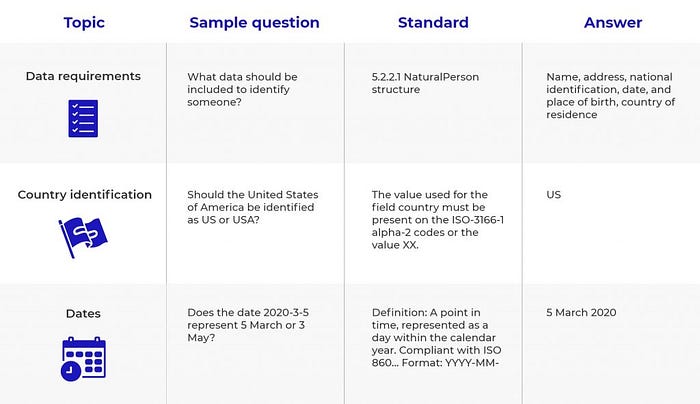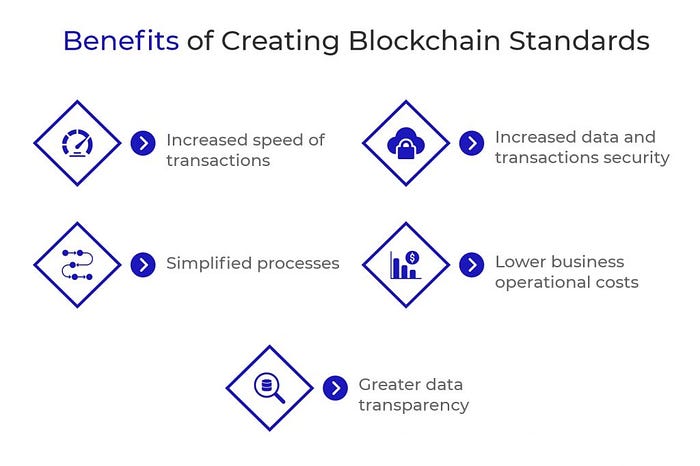Creating Blockchain Technical Standards

According to the 2020 Global Blockchain Survey, 55 % of respondents view blockchain as a top priority. Still, there are no unified standards for mass enterprise blockchain adoption.
Setting common standards is a prerequisite for blockchain adoption in the enterprise space. This also depends on how fast the standards for the most giant stumbling blocks, scalability, and interoperability, will appear. Many key players have formed and joined industry groups to work on specifications to speed this up. This task is not as glamorous as advertising ICO development, for example. It’s not as transparent and public either, as nations and corporations alike try to get to the finish line first. So it is quite a challenge to navigate the blockchain standards space. In this article, we’ll go to discuss creating blockchain standards.
EEA Blockchain Tech Standards
The EEA (Enterprise Ethereum Alliance) is a non-profit corporation consisting of startups, developers, and academics. It aims to develop open-source standards for enterprise deployment. The alliance hopes to provide means of streamlining enterprise blockchain solutions without having to venture into custom engineering to create private enterprise-ready Ethereum-based apps.
With a growing number of blockchain applications being developed on the Enterprise Ethereum blockchain, the demand for interoperability also increases. The EEA hopes that a standards-driven approach will help increase these developments. According to the EEU, common standards are of great importance in the web 3.0 blockchain evolution for the following three reasons:
- Standards that promote and support blockchain application development interoperability promote the organic scalability of enterprise solutions.
- Accredited testing and certification labs ensure interoperability and avoid vendor lock-in.
- In cases where EEA certification testing is required, enterprises can freely switch vendors with interoperability. Lower prices will be achieved through stronger competition.
The global standards Mapping initiative (GSMI), is based upon in-depth technical interviews of the major players. It represents an effort to map and analyze the current framework. It includes data from over 30 technical standard-setting entities, and nearly 400 industry groups to offer an overview of the current landscape to:
- Provide grounds to establish some clarity in terminology, as it remains inconsistent.
- Identify gaps and areas of overlap;
- Identify inconsistency across geography, expertise, and role.
The mapping is expected to help blockchain service providers and standard-setting organizations who should be able to rely on the produced standard-setting activities and the implementation of technical standards.

Major organizations considered:
- The IEEE(Institute of Electrical and Electronics Engineers) provides guidelines on the Internet of things (IoT), tokens, and digital assets.
- The BSI(the British Standards Institution) and the GDF(Global Digital Finance) deal with DLT requirements.
- The ITU-T ( the International Telecommunication Union Telecommunications) ensures the production of standards in security, IoT, identity, and DLT requirements.
Blockchain Standards are Important; here’s why:
This approach has some challenges ahead. These are
- Data and commercial governance of blockchain systems to determine the liability and responsibility of parties running in the network. This is an issue particular to regulatory attempts to enforce the law in case of disputes.
- No common terminology for blockchain to establish outcome-based industry performance standards. Picking the right platform on the basis of buzzwords instead of functional capabilities is likely to contribute to an overall project failure.
- There is no interoperability for blockchain platforms to eventually eliminate trusted third parties. The use of centralized authorities will be necessary for the absence of a technical solution for digital asset interchangeability.
These issues are identified by Blockchain consortia growing up around the world.
International Organization for Standardization led by Standards Australia which defined as its aim a Standardisation of blockchains and distributed ledger technologies to support interoperability and data interchange among users, applications, and systems. In April 2017 a Roadmap to achieve these aims was announced. It is worth reading this document as it establishes the main areas of interest towards standardization. These are:
- Reference architecture,
- Use cases
- Smart contracts
Ensuring smart contract technology is safe and secure by supporting best practices and standards.
- Security and privacy
- Identity

Overview of the Current Blockchain Technical Standard
- Terminology
Even in the timeline for the adoption of blockchain technology, inconsistency could pose a problem since terminology is the basis for all future standard-setting activities. As a result, it becomes necessary to ensure that language and intended use are precise, and consistent, even in the definition of blockchain itself.
2. Gaps and Overlaps
Major efforts have been focused on identifying gaps and overlaps. Collaborations among entities, users, and consumers should always be promoted as a way to mitigate the impact of gaps and overlaps in the current framework. It would help harmonize terminology and working definitions; provide a sequence of standard development, minimize redundancies and maximize the potential for boosting interoperability.
The top areas of overlap are:
- Security
Due to the existence of different types of blockchains, consistency in the security management of cryptographic assets, protection of customer assets, and security for DLT data access and sharing management systems should be ensured.
- Internet of Things
Technical standards should converge on the interoperability between IoT devices, hardware, and blockchain network protocols.

3. Key recommendations for standard-setting entities
In the paper, standard-setting organizations are recommended to recognize and carefully consider that standardization may be premature in some areas of technology. Setting standards too early may discourage innovation or lead to adverse incentives. Some standards may even be unnecessary. Decentralization should also always be considered when creating, planning, and implementing standards.
4. For entities adopting technical standards
Entities must follow ongoing standard-setting activities to avoid being left behind in important developments in cryptography, security, or interoperability. In the entire paper, collaboration with other organizations has been emphasized as an essential requirement to plan a comprehensive standard-setting landscape.
Conclusion
According to American financial services company, Moody’s, 2023 will be the year of blockchain standardization. This paves the way to real-cost-and-time-saving benefits via faster data availability, elimination of transaction parties, and automation.
Standardization would improve interoperability across systems and market participants, but also reduce counterparty concentration, and operational and legal/regulatory risks for transactions that use blockchain technology.
For a technology that is still considered a highly uncertain market, this is the turning point for its full legitimization and the much-needed interoperability across the whole ecosystem. It would help overcome the typical fragmentation that has slowed down adoption and innovation.
Stay tuned for the next article with more insights into blockchain technology, its use, and implications, by following Gyan Consulting.
